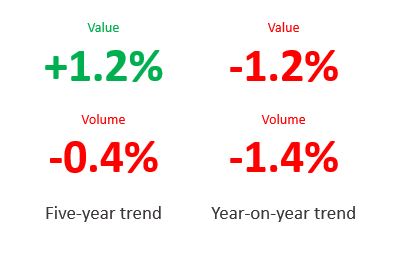Beef - taking stock of consumer trends
Monday, 25 November 2019
We have covered a lot in the last year on the changing consumer landscape, from in-home consumer trends within health, plant-based diets and ageing populations all affecting the beef market in differing ways, as well as overall trust and transparency in agriculture.
It is important to view all these trends together to see how they are affecting the beef market.
Beef market
Total beef volumes have declined by only 1.4% in the last year (Kantar); however, over the last five years, volumes for beef have remained relatively flat at -0.4%. This is not across all categories, however, with mince seeing spend and volume increases but steaks and roasting seeing steady declines. An article on the performance and trends within specific cuts is coming soon.
Total beef performance

Source: Kantar | Total beef universe | Five years: 52 w/e 11 Oct 15 vs 06 Oct 19; Year on year: 52 w/e 07 Oct 18 vs 06 Oct 19
When we ask consumers who say they have cut back on the amount of red meat they consume, health comes out as the top reason. However, we have seen an increase in those citing ethical and environmental factors (source: AHDB/YouGov Aug-19). When we look at the performance of the primary meats, poultry and fish, we can see that beef and lamb are in decline, whereas fish and poultry see large increases. This suggests that consumers are reducing their beef consumption in favour of perceived healthier and more environmentally friendly proteins.
Changing consumer cooking habits
This change in the proteins people buy is also influenced by changes in home-cooking trends, as people move away from more traditional meat and two veg type meals towards more dish-based and world cuisines, which tend to favour chicken and fish. Dish-based cuisine accounted for 49% of lunch and evening meals in 2008 but is now at 55% share in 2019, according to Kantar Worldpanel Usage.
Beef is seen as one of the tastiest and most satisfying meats. This is a core strength which needs to be a continued focus for beef.
% of consumers who agree each meat is tasty
Source: AHDB/YouGov – Aug 19
The top beef dishes cooked in home are spaghetti bolognese, beef pie and roast beef, according to Kantar. So although there is growth in world cuisines, traditional roasts and stews are still important to the category but are in decline. Beef needs to continue to look at ways to inspire with wider world cuisines to build on consumer momentum.
We are seeing an increase in the number of meals which are cooked from scratch in home and beef is 28% more likely to feature in scratch-cooked meals compared with other proteins, according to Kantar. Beef can, therefore, continue to capitalise on this trend.
Another area of opportunity for beef is to take advantage of special occasions. Beef performs strongly at romantic occasions, but there could be opportunities for beef to be promoted more at family and social occasions.
Key opportunities
- Fitting with the growth in dishes and seeing how red meat can play more of a role within the increasing number of world cuisines
- Building on strengths of taste, treat and enjoyment, as well as communicating the health benefits, giving people permission to eat
- More convenient cuts like mince and ready to cook are performing well, so highlighting quick and easy meals is important to retain time-poor families
Related content
Topics:
Sectors:



